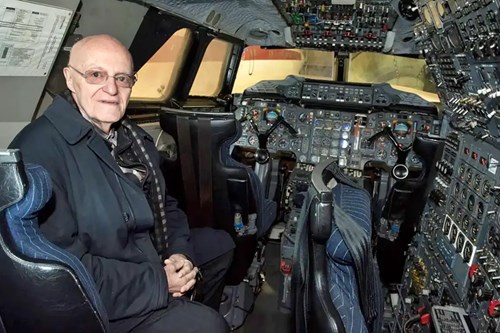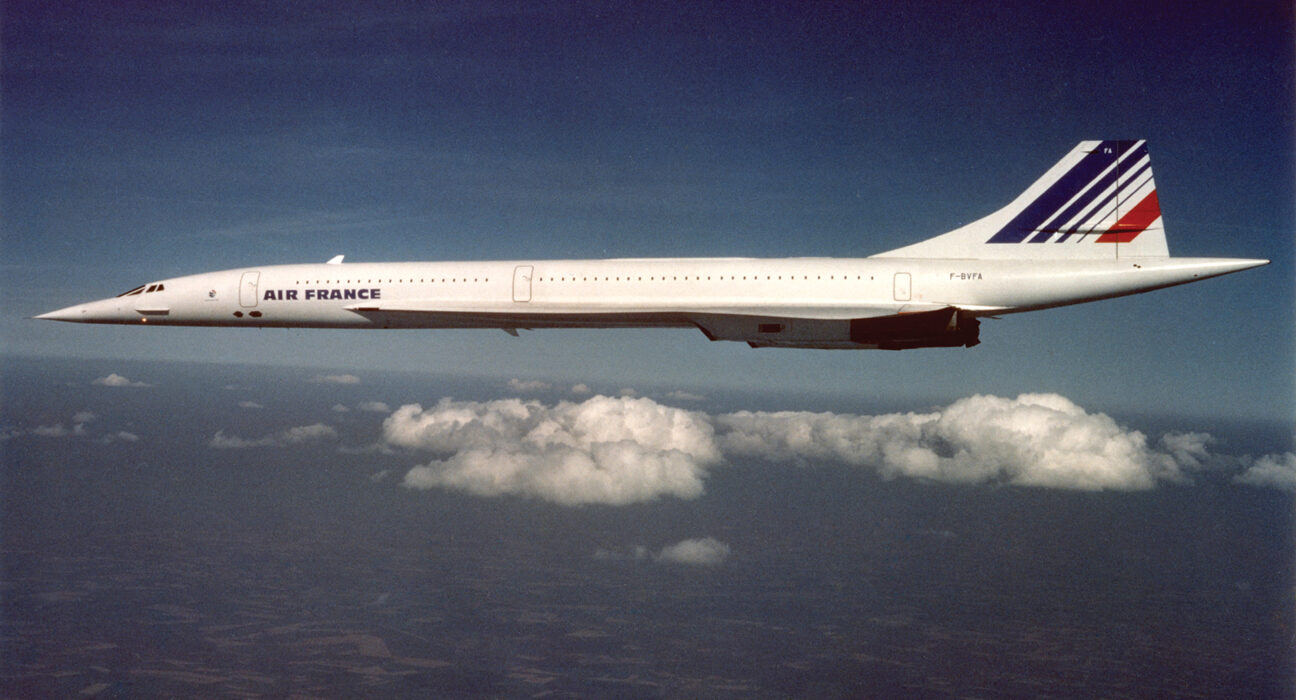Two decades on from its final flight, Concorde continues to amaze and fascinate. Former President of Académie de l’air et de l’espace and test pilot JEAN PINET, who, along with Andre Turcat, was the first Concorde pilot to break the sound barrier, offers his thoughts on this remarkable machine.
Two decades after its quarter of a century of service, Concorde still arouses the admiring interest of a public who never had the chance of benefiting from it. How can one explain this in a century polarised by the precautionary principle, environmental protection, decarbonisation and profitability? Especially when the interest often comes from young people already saturated with ultra-motivating technologies. Why does this aeroplane experience this enduring interest?
There are many reasons to forget

Jean Pinet is a former test pilot, member and former President of France’s Air and Space Academy. (Museum d’air et Space)
Firstly, how can one ignore the criticisms levelled at it, consigning the object to oblivion with derogatory references? The aircraft was noisy; it guzzled a huge amount of fuel; only the rich could afford it; it was not profitable to operate and it had an accident. However, let’s look at each of these points in turn. Are there any mitigating circumstances?
The majestic, deep roar announcing its departure or return drew many spectators to windows and doors to admire its perfect silhouette. It is true that our tired ears would not nowadays tolerate the decibels. On the other hand, the sonic boom was wisely reserved for seagulls and boats.
The high speed and shock waves generated for supersonic flight were paid for by a significant increase in the energy required and, therefore, in the amount of kerosene burned, since the laws of physics cannot be bypassed. The result was atmospheric pollution, ozone, carbon monoxide and nitrogen compounds. However, it was not the only polluting agent among the thousands of subsonic aircraft flying around the world, and the dozens of rockets that now take off every year in clouds of toxic smoke.
The inevitable consequence was an increase in the cost of travel, as only passengers with sufficient financial means could board. However, it was not just the ‘rich’, far from it: the aircraft competed with business aviation and the first and business classes of subsonic aircraft. It carried all sorts of professionals with limited time to spare.
It was handicapped by rapid technological evolution towards digital technology. Its systems were analogue, delicate and physically complex, and there were only 14 aircraft in service. It was, therefore, impossible to apply the classic rules of financial depreciation used in the incessant modification of subsonic aircraft built by the hundreds. Spare parts became expensive because their technical level could not keep up with the constant progress of technology.
Then, there was the accident! This fatal crash causes us to overlook a major event in world aviation, in the certification of aircraft. The certification rules of the time could not be applied to Concorde’s wide flight envelope and special configuration. For it, and thanks to it, new reliable rules were developed based on the probability of events, and are now applied worldwide. They indicate that the catastrophic chain of events in 2001 was highly improbable and unforeseeable by the aviation community, when the aircraft had been properly certified.
This jumble of negative and positive considerations, 20 years after Concorde stopped flying, might tend to bring about rapid loss of its memory, through indifference. So many remarkable aircraft have already been forgotten! Indeed, forgetfulness is creeping into people’s minds. Despite factual recognition, the advantages procured by some of Concorde’s innovations have dissolved into the fabulous success of Airbus.
For the younger generation, the A320 is gradually becoming the first airliner with fly-by-wire controls; was Concorde ever part of the air transport business? There is nothing remarkable about this classic, normal psychological process in favour of an aircraft that is appreciated all over the world.
Finally, still on the subject of forgetting, the enthusiastic support of the ‘Mach 2.02’ epic is reduced to increasingly rare survivors. It should be noted that the disappearance of direct witnesses also means the vanishing of associated know-how and skills.
How does this interest persist?
Concorde was the product of draftsmen working with pen, ink and drawing boards. It was created with love and attention to detail. (BAE Systems)
We often speak of the Concorde myth. A myth relates to the immaterial, but Concorde did exist and its material remains are in museums. Its remembrance, therefore, has material substance, but the virtuality imposed by our digitalised society encourages the tendency to wrap it in a myth, even a dream.
What remains is a network of explanations that some will dismiss, mainly because of a kneejerk rejection of any object that does not conform to current ideas and norms.
While adventure and beauty continue to haunt the souls of many, Concorde gives a real, concrete, lived image, authenticated by millions of people for 40 years. Not just by a few hundred privileged people, and perhaps mixed in is a very human emotion that tends to be impoverished by current events: pride.
Adventure!
G-AXDN under construction at BAC’s Filton facility in 1971. (BAE Systems)
In the past, today and perhaps for a long time to come, those lucky supersonic few have needed to wear anti-G suits, helmets and oxygen masks. They fly at Mach 2, sitting in an ejection seat, for tens of minutes at best.
In 1962, two nations, France and Great Britain, took the unprecedented risk together of launching an aircraft in which the passengers would sit comfortably in everyday clothes for a flight of more than two hours at a speed of 1,400mph – that of a missile! What government today would take such a risk?
At that time, the adventure of flying lay in the trio of dimensions, speed and distance. This has not changed, despite an overall, persistent will to reduce these three factors in the name of the planet. The survival of the planet is certainly a worthy goal, but necessity does not always motivate passion.
Hundreds, then thousands of people, were immediately excited by the supersonic challenge. The task was difficult because almost everything was innovation and invention, but the passion and resilience of the players overcame the obstacles. And the aircraft flew, and flew well. After the improvements necessitated by unforeseen factors of an unfamiliar flight envelope, 14 years later, it responded to the challenge of the two nations with the simultaneous commercial operation of Concorde by Air France and British Airways, and later by the American Braniff.
Concorde’s unique silhouette brings to mind the adventures of the hundreds of thousands of artisans who designed, built and maintained it, the thousands of passengers it carried, and the hundreds of crew members who flew and served it. They all shared in its extraordinary, unique performance in terms of speed and comfort, a magnificent technological feat designed and built with a modesty of means that astonishes our young engineers.
Today, digital technology brings virtual adventure within reach, without effort. There is also a political will on the part of certain persons to keep young people away from real, tangible adventure. Despite that, the attraction of ‘true’ adventure remains anchored in the human brain, and the evocation of the real, technical and above all human adventure of the Concorde, combined with the memory of its unforgettable silhouette, could explain the interest one can observe, similar to that for a beautiful and unique work of art.
Beauty!
Head on elegance, (BAE Systems)
Concorde is indeed beautiful. With the elegant aerodynamics of a speed champion, its racing profile forces admiration at take-off as it powers forwards.
On landing, its majestic stance is that of a champion returning victorious from a race. Whether on the ground, moving or still, or in flight when it can be seen, it involuntarily attracts and holds the eye.
Pride!
Soaring into the future. (BAE Systems)
We were proud of our achievement. Faced with the retirement from the supersonic race of the Boeing, we managed to get a jump on the American west in meeting the challenge, and on the Soviet east by winning the competition against the Tupolev Tu-144.
Today, Concorde shows that our old Europe is still capable of remaining at the forefront of human adventure, and the pioneering spirit of the French and British of that time passed on to the Germans and then to the Spaniards to create the formidable Airbus organisation. The pride of a shared aviation culture that is crystallised in Concorde is still clearly evident.
A work of art!
Aerial artwork? (BAE Systems)
The Musée de l’Air et de l’Espace presents parts of Concorde as works of art. Why shouldn’t the aircraft, which is also on display in the museum, be a work of art, allowing us to dream?
Certainly, it was admired by millions of people around the world for a third of a century, many more than Calder’s Mobiles. It continues to be venerated in European and American museums. Will it compete with the astronomical clock in Strasbourg Cathedral, London’s Big Ben or America’s Mount Rushmore?
Like any work of art, it can be copied. Later perhaps? But only the original will be authentic. Twenty models were made, not all identical but numbered, some of which have already disappeared. The Air and Space Academy has the privilege of owning Concorde No 1 (F-WTSB) which is on display at the Aeroscopia Museum next to Air France’s serial number 9, F-BVFC. They make visitors dream!

